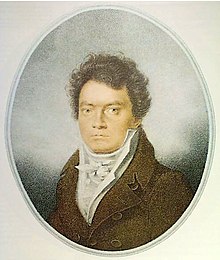Cello Sonata No. 4 (Beethoven)
The cello sonata No. 4 in C major op. 102.1 is a sonata for piano and cello by Ludwig van Beethoven .
Emergence
Beethoven wrote the cello sonatas op. 102 for his long-time patroness, Countess Anna-Maria Erdődy , and Joseph Linke , the cellist of the Schuppanzigh Quartet , with whom Beethoven was closely connected, especially through the performance of his string quartets. The two cello sonatas op. 102 were composed in the summer of 1815 and were premiered by Linke together with Beethoven's student Carl Czerny .
To the music
At the time of the composition of the cello sonatas op. 102, Beethoven, who was busy with the revision of his opera “ Fidelio ”, wrote hardly any new music except for the piano sonata No. 27 op. 90 , but concentrated on Johann Sebastian Bach's music and specifically with its fugues, which is also reflected in his last two cello sonatas. The sonatas op. 102 are among Beethoven's late works.
The sonata op. 102,1, called “Freje Sonata” in the autograph, is made up of two fast movements, each with a slow introduction; Such a scheme can not be found again in Beethoven's work.
1st movement: Andante - Allegro vivace
Musicologist Carl Dahlhaus described the structure of this movement with an Andante introduction in C major and the subsequent Allegro in A minor as a “tonal anomaly” .
Beethoven deviates from the sonata form in some places , for example by breaking off the repetition of the theme and instead being followed by a six-bar section with a transition character, which Hermann Danuser described as the “fragility of musical processuality” . Furthermore, the melody of the second theme is not suitable as a secondary theme, but rather has the character of a transition group. In carrying out again the topic development is complete after 15 cycles. The use of the recapitulation is also inconsistent if it only begins in the cello and the piano bass and the upper part of the piano starts late.
The Andante, which is divided into five song lines, provides the motivic basis for the entire sonata, with which Beethoven further developed the idea of unification suggested in his Cello Sonata Cello Sonata No. 3 in A major, Op. 69 . The main and secondary voices as well as the accompaniment in the Andante are not composed according to the sonata scheme, but rather form a complex of interwoven voices, with Beethoven taking Johann Sebastian Bach's A major violin sonata BWV 1015 as a model.
2nd movement: Adagio - Allegro vivace
For the composition of the Adagio introduction to the second movement, Beethoven took Johann Sebastian Bach's Violin Sonata in E major BWV 1016 as a model. Musicologist Martin Zenck sees parallels between the two works “through their becoming an integral part of the melody” and the character of both movements as “richly ornamented instrumental recitative with arioso elements”. A variation of the Andante at the beginning of the sonata follows.
Originally Beethoven planned a fugue in place of the rondo as in the Sonata op. 102,2 , but instead composed the present fugato. The main theme of the final movement has anticipatory echoes of the overture to Beethoven's " The Consecration of the House " from 1822.
effect
Both cello sonatas op. 102 are dedicated to Countess Anna-Maria Erdődy. The first print of the sonatas was published in 1817 by the Simrock publishing house in Bonn .
The contrapuntal character of both sonatas caused confusion. Alluding to the sonata op. 102,2 , the finale of which is composed as a fugue , Adolf Bernhard Marx wrote in the “ Allgemeine Musikalische Zeitung ” in 1824 about the finale of op. 102,1: “Such a movement is worth more, as a multitude of joints, however artificial, that do not meet higher requirements ” .
literature
supporting documents
- Booklet for the double CD Beethoven - Complete Cello Sonatas 1–5. Philips (Universal), 2004.
- Harenberg cultural guide chamber music. 3rd, completely revised edition. Meyers Lexikonverlag, Mannheim 2008, ISBN 978-3-411-07093-0 .
- Jürgen Heidrich: violoncello sonatas. In: Sven Hiemke (Ed.): Beethoven-Handbuch. Bärenreiter-Verlag et al., Kassel et al. 2009, ISBN 978-3-7618-2020-9 , pp. 476-482.
further reading
- Carl Dahlhaus : On the concept of the thematic in Beethoven. Commentaries on Opus 95 and Opus 102, 1. In: Friedhelm Döhl (Ed.): Beethoven '77. Contributions to the Beethoven Week 1977. Organized by the Basel Music Academy. Amadeus, Zurich 1979, OCLC 601814077 , pp. 45-64.
- Hermann Danuser : Beethoven's Cello Sonatas opus 102. Some thoughts on form and interpretation analysis. In: Friedhelm Döhl (Ed.): Beethoven '77. Contributions to the Beethoven Week 1977. Organized by the Basel Music Academy. Amadeus, Zurich 1979, OCLC 601814077 , pp. 65-78.
Web links
- Cello Sonata No. 4 in C major, Op. 102.1 : Sheet music and audio files in the International Music Score Library Project
Individual evidence
- ^ Carl Dahlhaus: On the concept of the thematic in Beethoven. Commentaries on Opus 95 and Opus 102, 1. In: Friedhelm Döhl (Ed.): Beethoven '77. Contributions to the Beethoven Week 1977. Organized by the Basel Music Academy. Amadeus, Zurich 1979, pp. 45-64.
- ↑ Hermann Danuser: Beethoven's Cello Sonatas opus 102. Some thoughts on form and interpretation analysis. In: Friedhelm Döhl (Ed.): Beethoven '77. Contributions to the Beethoven Week 1977. Organized by the Basel Music Academy. Amadeus, Zurich 1979, pp. 65–78, here p. 68.
- ↑ a b Martin Zenck : The Bach Reception of the Late Beethoven. On the relationship between music historiography and reception historiography of the “classical” (= archive for musicology . Supplement 24). Steiner, Stuttgart 1986, ISBN 3-515-03312-0 (also: Berlin, Free University, habilitation paper, 1982).
- ↑ Booklet to the double CD Beethoven - Complete Cello Sonatas 1–5. 2004, p. 26.
